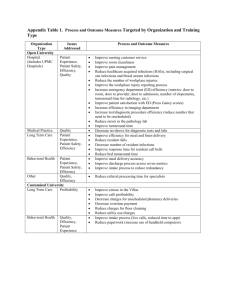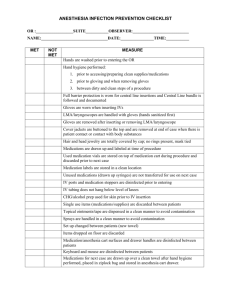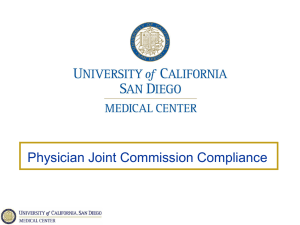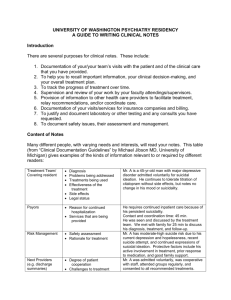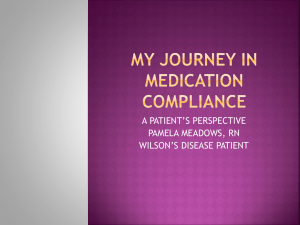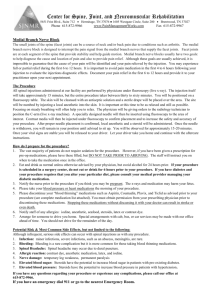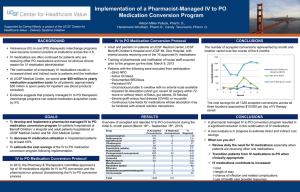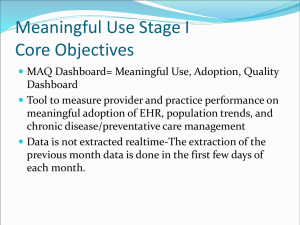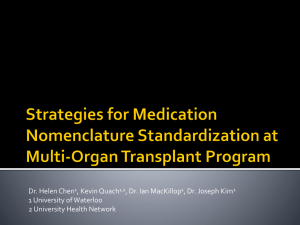GOAL - UMass Memorial Health Care
advertisement
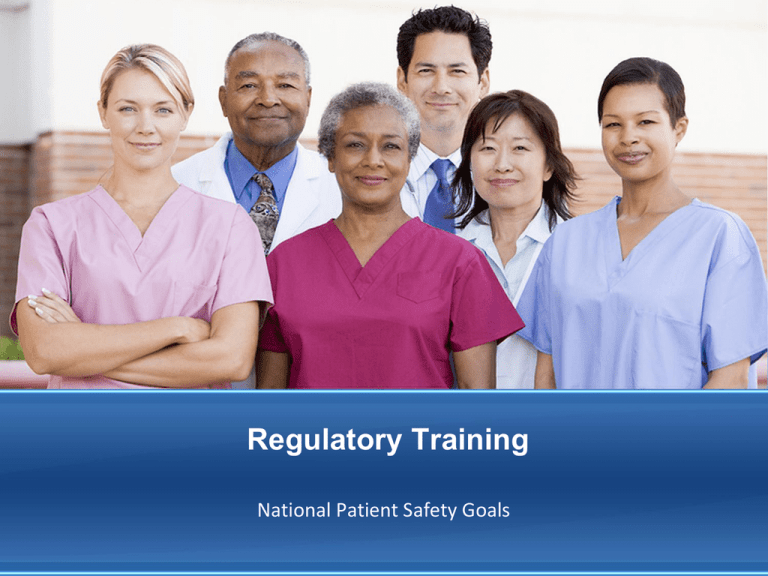
Regulatory Training National Patient Safety Goals Introduction The Joint Commission helps ensure quality health care through the development of standards for patient safety. Health care facilities undergo review by the Joint Commission to ensure that health care facilities comply with the standards and regulations set forth from the Joint Commission and Centers for Medicare and Medicaid Services (CMS). Each facility is reviewed and if the facility meets the criteria, then it will receive an accreditation, which is renewable every three years. Our last Joint Commission survey was in November 2011. The purpose of this training module is to familiarize you with certain standards and to better prepare you for providing the highest quality of care possible. This module is divided into three sections: • National Patient Safety Goals • Medical Record Documentation • Patients' Rights National Patient Safety Goals National Patient Safety Goals (NPSG) promote specific improvement in patient safety. NPSGs are important to the delivery of safe, high quality health care. Why are the NPSGs important? • • • If followed, they will help to prevent harm to our patients. Safety goals are inherent to a culture of safety. Patient safety is central to the Joint Commission review. These goals address identified problematic areas across health care. UMass Memorial is committed to making our organization a safe place to receive care. Patient safety is everyone's responsibility. Following NPSGs and Patient Safety Standards helps promote that safety. GOAL: Accurate Patient Identification Goal: Improve the accuracy of patient identification. Use at least 2 patient identifiers whenever providing care, treatment, or services: • For inpatient – use patient’s name and medical record number (MR#) • For Ambulatory – patient name and date of birth (DOB) • Compare the name and MR# or DOB to the label, medication administration record, or service/procedure to the name and MR# (or DOB) on the patient’s wristband • The patient’s room number or physical location is not used as an identifier • Specimens must be labeled in the presence of the patient Eliminate Transfusion Errors Before initiating a blood or blood component transfusion: • Match the blood or blood component to the order, • Match the patient to the blood component, • Use a 2 person verification process. One individual conducting the verification is the qualified transfusionist who will administer the blood. Second individual conducting the identification verification is qualified to participate in the process, as determined by the hospital. GOAL: Critical Values Goal: Report critical results of tests and diagnostic procedures in a timely manner. • The reporting should be done immediately, but no longer than 60 minutes after the results. • When critical value or critical test result information is provided by telephone, the critical value or critical test result should be written down, or entered into a computer, and “Read Back” by the receiving licensed independent practitioner (LIP)/nurse; the caller then confirms that the result has been received correctly. GOAL: Improve Safety of Medications Goal: Improve the safety of using medications. • • • Label all medications, medication containers (e.g., syringes, medicine cups, basins), or other solutions on and off the sterile field in peri-operative and other procedural settings Label as soon as the medication is removed from the original container if it is not to be used immediately The label should contain: • • • • • • • Medication name Strength of medication Quantity Volume (if not apparent from container) Expiration date and time when not used in 24 Hours Expiration time when expiration occurs in less than 24 Hours Immediately discard any medication or solution found unlabeled GOAL: Prevent Health Care-Associated Infections (HAIs) Goal: Use evidence-based practice or evidence-based guidelines for preventing health care-associated infections. See the Infection Control module for details. • Hand hygiene • Cleaning and disinfecting patient care equipment • Healthcare-associated infections due to Multiple DrugResistant Organisms in Acute Hospitals such as MRSA, CDI, and VRE • Central line-associated bloodstream infections • Implement Best Practices for preventing surgical site infections • * New- Implement evidence- based practices to prevent indwelling catheter- associated urinary tract infections (CAUTI) GOAL: Reconcile Medications Goal: Accurately and completely reconcile medications across the continuum of care. • Obtain a list of medications the patient is taking prior to the encounter; • Compare that list with any new orders written; • Give the patient and family written information on medications they will be taking when they go home; • When the patient exits the care setting, explain the importance of keeping an accurate medication list, including giving the list to his or her physician. GOAL: Minimize Risk of Suicide Goal: Identify patients at risk for suicide; this applies to psychiatric hospitals and patients being treated for emotional or behavioral disorders in general hospitals. • Conduct a risk assessment of the patient and environmental features that may increase or decrease the risk for suicide. • Address the patient’s immediate safety needs and the most appropriate setting for treatment. • When a patient at risk for suicide leaves the care of a hospital, provide suicide prevention information (like a crisis hotline) to the patient and his or her family. GOAL: Universal Protocol Goal: Actively involve team members to protect patient safety by verifying Correct Patient Identity, Correct Site/Side, Correct Surgery/Procedure. Includes 3 key processes: 1. Pre-Procedure Verification • Use a standardize list (Checklist, Surgical Safety Checklist, Script) • Verify correct patient, correct procedure, correct site and side • All relevant documents such as History & Physical, diagnostic and radiology test results, and the consent form are present and correct 2. Marking the Site • All patients having an invasive procedure or surgical procedure that involves laterality, multiple structures or levels (e.g. spinal levels) 3. Time Out • Formal verification of correct patient, procedure, site, and side • Needs to be documented in the medical record • Time out process needs to include active participation of the entire team (all members stop activities to participate in the time out process) Telephone and Verbal Orders • A telephone or verbal order needs to be verified by writing the order in the Medical Record, reading it back to the LIP, and having the LIP acknowledge that it is correct • The order needs to be authenticated by signing within 48 hours Dangerous Abbreviations The following abbreviations are prohibited anywhere in the medical record: ***Do not use dangerous abbreviations when writing in the Medical Record*** • U (for unit) • IU (for international unit) • Q.D. • Q.O.D. (any form) • Lack of leading zero (.X mg) • MS, MSO4, MgSO4 • T.I.W. (for three times a week) Do not use dangerous abbreviations anywhere in the medical record including: • Orders (including medication, lab, procedure, verbal/telephone) • Pre-printed forms • Transcribing into medication administration record (MAR) • Medication-related documents (handwritten or electronic) • Progress notes • Flow chart • Consult notes Improve Handoff Communication Multiple handoffs occur within every Health Care Organization. Information required during handoffs includes: • Patient name and medical record number or date of birth • Location of patient • Name of physician directing the care of the patient • A summary of the patient’s pertinent medical history • An opportunity to ask questions • An opportunity to review relevant historical data (as appropriate) Poor communication among health care providers is the #1 cause of serious harm to patients. Support Person Patients have the right to have a person of their preference stay with them during their hospitalization or appointment.
